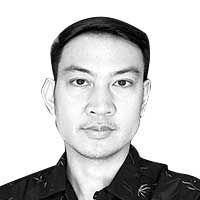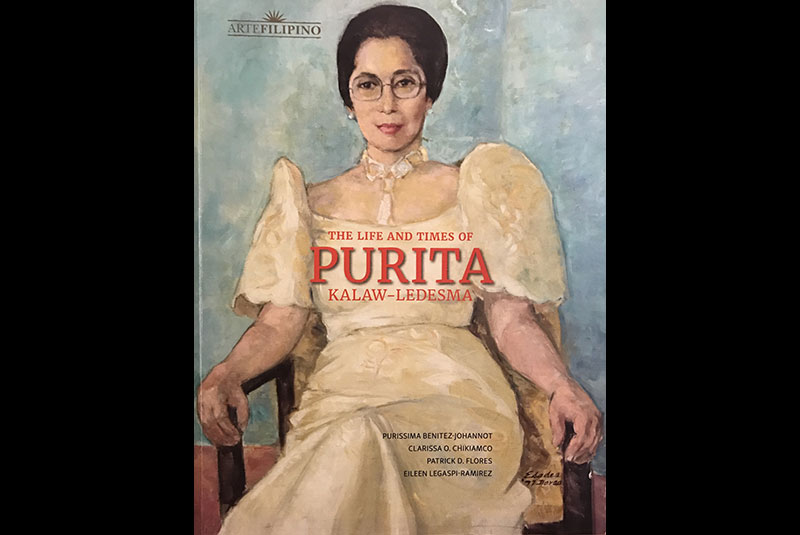Through her archives, a portrait of Purita Kalaw-Ledesma and her times


The Life and Times of Purita Kalaw-Ledesma chronicles the contribution of Purita Kalaw-Ledesma to Philippine modernism through the act— and art — of archiving and features scholarly articles by Purissima Benitez-Johannot, Clarissa Chikiamco, Patrick D. Flores, and Eileen Legaspi-Ramirez.
As an art scholar, historian, and patron, the reputation of Purita Kalaw-Ledesma (1914-2005) is assured, resting upon her contribution as the founder of the Art Association of the Philippines and author of some of the most seminal books on Philippine modernism. But as an archivist?
“My mother is well known for her art collection, but the archives, the scrapbooks, are not well known,” begins Ada Ledesma-Mabilangan, the daughter of Purita and president of Kalaw-Ledesma Foundation (KLF).
As it turns out, Purita had immersed herself in the process of scrapbooking — then the unlovely term for archiving, which has now become a buzzword in contemporary art — meticulously collating newspaper clippings, press releases, and notes, among others, starting in 1948. She would conclude this opus on January 2000, signifying an end not only to the 20th century but to an era of Philippine visual arts as she knew it. Her assiduous cutting and pasting in all those 52 years produced a grand total of 83 scrapbooks — hefty volumes bursting at the seams.
This aspect of her art historical practice is chronicled in The Life and Times of Purita Kalaw-Ledesma, published by Vibal Foundation and KLF, formally launched last May 17, at the home of the foundation and the archive at the KL Tower in Makati City. Graced by a portrait of Purita painted by National Artist Victorio Edades in 1997 on the cover, Purita is shown seated wearing a luminous golden terno, her gaze traversing past the viewer’s gaze into the horizon, into the probable future of the new millennium.
Part of the ArteFilipino series (which has included, among its featured artists, David Medalla, Lee Aguinaldo, and Carlos “Botong Francisco) and edited by Purissima “Petty” Benitez-Johannot, the full-color book features contributions from Clarissa “Lisa” Chikiamco, Patrick D. Flores, Eileen Legaspi-Ramirez, and Petty herself who, in their own scholarly turns, engaged with the archives (and in Patrick’s case, the master’s thesis of Purita), breaking ground for how future scholars, students, and enthusiasts could navigate the brimming thickets of the Purita archive. Interspersed with the articles are historical photographs and printed matter as well as images of artworks from the foundation’s collection.
Eileen, who currently teaches at the Department of Art Studies of UP Diliman, knew about the archives as early as the mid ‘90s. “I just began graduate studies and I visited Purita to actually do an interview with her because I was at the time still thinking of doing work about my grandfather,” — National Artist Cesar Legaspi. “And I saw her physically doing her scrapbooking. That’s my most complete memory of the archive.”
Eileen was also to access the archive in the library of the now defunct ASEAN Institute of Art — a windowless space, more storeroom than a library, quietly harboring what would eventually become an explosive treasure trove for researchers, especially those looking into the rise, progress and dominance of modernism in the latter half of the 20th century.
In the book, Petty describes Purita’s assiduous collation as such: “She filled reams of album paper with news clippings and ephemera, compiling these as numerically marked hardbound series. Although others wrote the journal pieces that she clipped, Purita conceived, collected, and organized the archives, playing a decisive role in labeling and preserving their contents for posterity.”
Alongside the clippings and ephemera, are in Petty’s words, “Purita’s nachlass — her corpus of notes and letters — (that) provides a rare circumstance for the patient researcher willing to troll through hundreds of pages and lists that map out ideas, activities, and relationships that Purita formed during that period.”
Lisa, a curator of the National Gallery Singapore (NGS), wasn’t aware of the existence of the archive, “but based on how Purita was so central to the art scene, I figured she must have had some materials. So that’s when I emailed Ada and asked her about it. It turns out there was so much material. To our great delight, we found out that they were already digitized.”
A back and forth between the KLF and NGS ensued, culminating in the loan of scrapbooks and a talk by Ada titled, “Philippine Art History and the Purita Kalaw-Ledesma Archives,” at the museum early this year. “I was very touched that there was an entity outside the Philippines who saw the value of the scrapbooks,” Ada says.
The archive isn’t just a record of the moderns, who Purita championed energetically during her lifetime. “She was very democratic with what she allowed in the archive,” Eileen says. “There are artists that didn’t apparently make it to the attention of the mainstream writers, but they are there because she kept their invitations, their press releases. That’s important. That’s one way of telling the stories that don’t get told. In a way, she was a populist in that regard, in the kind of art that she would pay attention to.”
As a collection of firsthand materials, the archive cannot only potentially prompt new narratives but reshape existing ones. In Eileen’s case, for instance, materials “from the ‘70s that Purita actually donated money to some underground publication” —a subversive act that could have bode ill for Purita if discovered during the Martial Law era. For Lisa, she discovered that the so-called walkout of the conservatives during the AAP and Rotary show in 1955 was not as polarized as the textbooks have made it appear; a few of the moderns also joined the protest as, just like the conservatives, “they were asking for transparency in the judging process.”
No Filipino art historian worth her salt can neglect the Purita archive. “Art history will be reviewed, which is au currant now,” says Petty. “You review the same-old, same-old story, the same-old, same-old narrative and you retell it. Even for the future it can be retold. (Because of its digitization), it’s much more accessible, the archives. Hopefully, the other archives around the city will also become accessible in that way…The foresight of Purita doggedly cutting from 1948 to 2000 — that’s really a gift for our heritage and our culture.”
Now, even international scholars have gotten news of the archive, getting in touch with the foundation and wanting to dip their fingers into its untold riches. With its newfound significance in modern art, the archive further redefines, refines and expands the contribution of Purita Kalaw-Ledesma. “What make our work so easy, it’s because of her good name and her integrity,” says Ada. “People have been coming to us to seek partnerships, and I tell my children, ‘It’s nothing that we did. It’s my mother’s good name.’ And so I tell my children, ‘That’s your inheritance, the good name.’”

Ada Ledesma-Mabilangan (seated), the daughter of Purita and president of Kalaw-Ledesma Foundation, states that the The Life and Times of Purita Kalaw-Ledesma sets the tone on how the Purita archive may be used by future scholars. With Mabilangan are authors Eileen Legaspi-Ramirez, Clarissa “Lisa” Chikiamco, and Purissima “Petty” Benitez-Johannot, who also serves as the editor. Not in the photo is Patrick D. Flores.Photo by ERNIE PEÑAREDONDO
* * *
For inquiries, call Liza Altajeros at 0943-3539798 or email at kalawledesmagroup@yahoo.com.



















